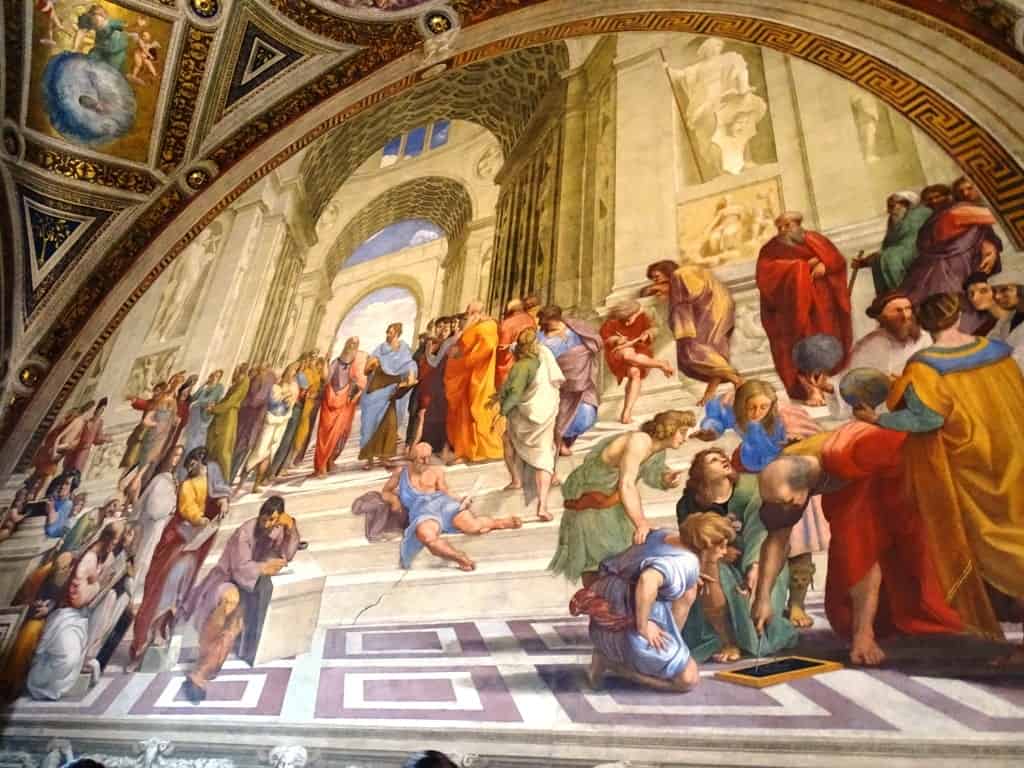Over the centuries, Italy has produced many fine painters, who have become household names. Italy was at the heart of the Renaissance period which spanned the 14th-17th centuries. Italian painters and sculptors had an incredible influence on European art and architecture and were major contributors to its rich cultural history. In this post, you will find the most famous Italian paintings and where to see them.
Disclaimer: This post contains affiliate links. This means that should you click on certain links, and then subsequently purchase a product, I will receive a small commission.
Table of Contents
12 Must-See Italian Paintings
1. Mona Lisa by Leonardo da Vinci (1452- 1519)
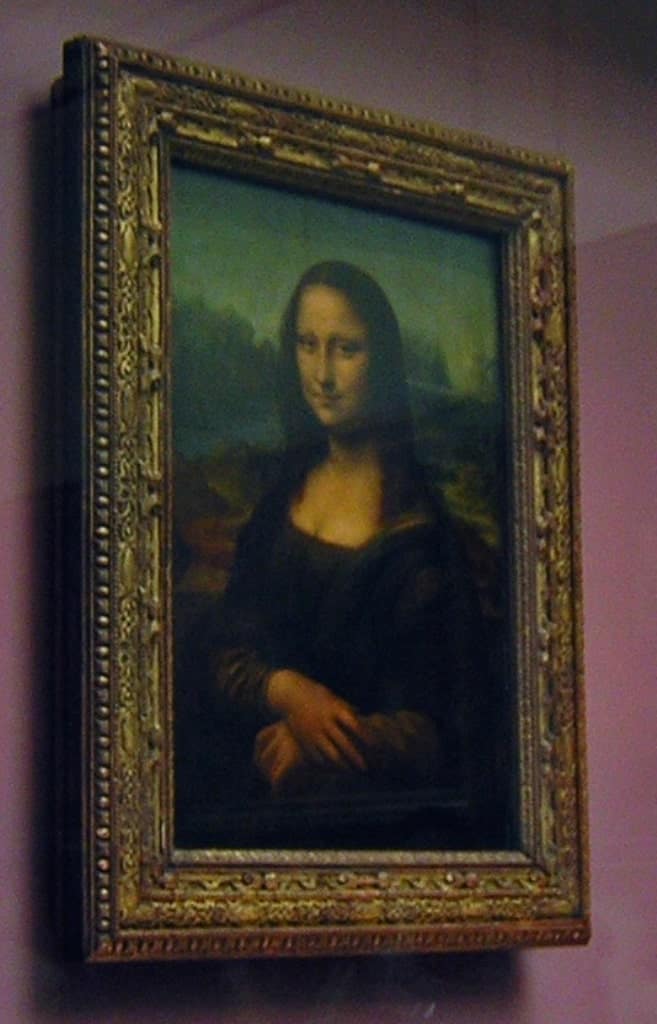
The painting of the Mona Lisa by Leonardo da Vinci is priceless and has been described as “the best known, the most visited, the most written about, the most sung about and the most parodied work of art in the world”.
The painting was started in 1503, but not completed for four years. It is a portrait of Lisa del Gherardini, who lived in Florence and was married to a wealthy silk merchant. The couple commissioned the painting for their new home and to celebrate the birth of their second son, Andrea. The painting was made on a panel of white poplar wood and measures just 77 X 53 cm. The couple never received their painting and Da Vinci was never paid.
In 1515, Leonardo da Vinci was invited to France by the king, Francis I. The painter traveled by mule across the mountains from northern Italy and carried with him his sketch pads and some paintings- including the Mona Lisa. He gave the painting to the king as a gift and the king displayed it in the palace of Fontainebleau. Da Vinci died in the Château du Clos Lucé in the Loire. Later Louis XIV moved the painting to Versailles, where it hung for many years.
Today the Mona Lisa is displayed in its own room with a glass ceiling in the Louvre in Paris. The painting is in a special thermostatically controlled display case.
Click here to buy a timed entrance ticket to the Louvre.
2. The Last Supper by Leonardo da Vinci
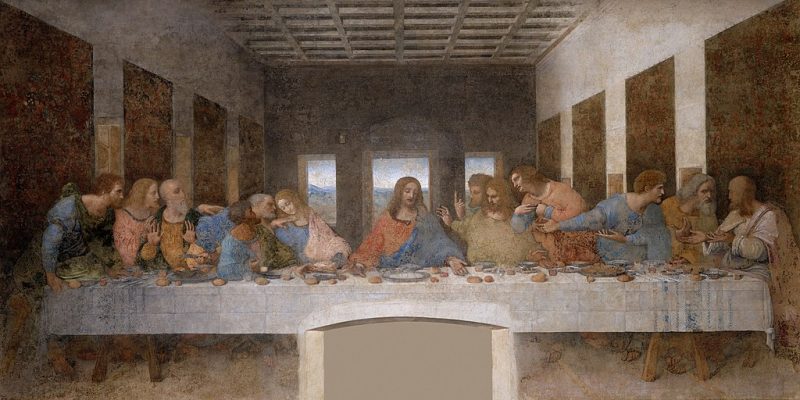
This magnificent painting has been much studied and much copied. The original measures 4.5 meters X 8.8 meters and was painted by Leonardo da Vinci on the wall of the dining hall in the convent of Santa Maria Delle Grazie in Milan. The painter was experimenting with a new technique. First, he primed the whole wall, and then he began to paint using tempura.
Tempura is a special type of paint made from egg or fig milk. Da Vinci was keen to try this new technique as usually wall frescos of this size were painted on wet plaster, but they had to be hurried as the plaster would dry quickly. Da Vinci wanted to be able to capture expression in The Last Supper, using intricate details.
Sadly, the experiment was not successful and within a few years, the paint began to flake badly. Within just 50 years, the painting was ruined. Restoration attempts only made things worse. During the Second World War vibrations caused by Allied bombing further damaged the painting and in 1980 restoration work began. The work took 19 years to complete, but much of the original detail was lost.
The Last Supper portrays Jesus sharing a meal with his apostles before he was captured and crucified. Leonardo da Vinci’s painting portrays the moment during the meal when Jesus tells his disciples that one of them is going to betray him and the apostles express great shock and rage.
The painting of The Last Supper is one of Italy’s top attractions. Unfortunately, because of the size of the convent, only 25 visitors are allowed entrance at a time. It is important to book your visit online well in advance – two months is average.
As Santa Marie Delle Grazie is a working convent, visitors must dress modestly or they will be turned away.
Click here to book a Da Vinci’s Last Supper Guided Tour.
3. The Birth of Venus by Sandro Botticelli (1455-1510)
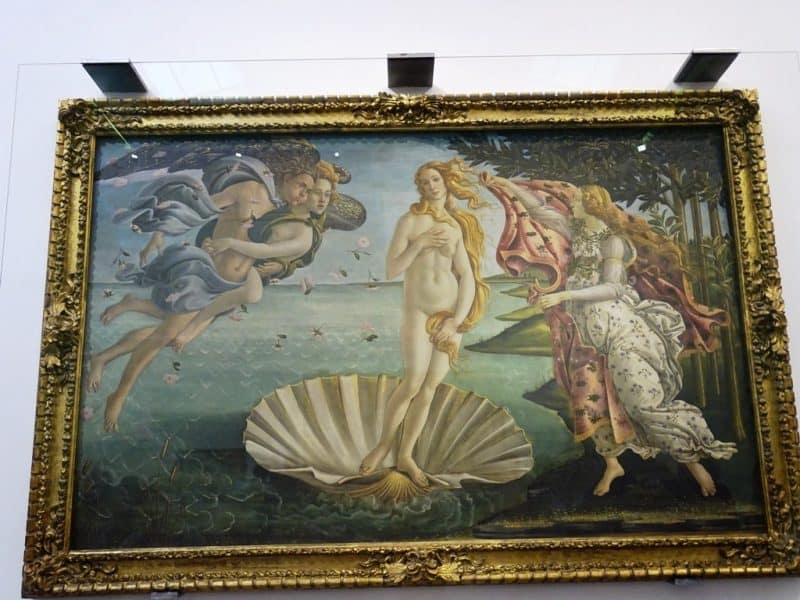
Sandro Botticelli lived in Florence which was where the Renaissance began. He is best known for this painting and it is considered an icon of the Renaissance. His paintings can also be seen in the Sistine Chapel in Rome.
The Birth of Venus is a huge painting measuring 1.72 cm X 2.78 cm which means that the painter’s portrayal of the goddess of love and beauty is almost life-size. Botticelli sewed two canvases together to give him the size for his dramatic work, which he painted in tempera and embellished with gold leaf. He began the painting in 1495 and it took him one year to complete.
The scene of the painting is taken from mythology and depicts Venus, the goddess of beauty and love. Following her birth, she was carried ashore standing in a giant scallop shell. The goddess is shown emerging from the sea as a woman. She arrives on a beach on the island of Cyprus where she has the Greek name, Aphrodite. The beach where she came ashore can be visited and is Petra tou Romiou, on the south coast, halfway between Limassol and Paphos.
Botticelli’s painting reveals the beauty of the goddess and shows her being blown ashore by Zephyr, the god of the West Wind with pretty flowers falling from the sky to welcome her.
The Birth of Venus can be seen in the Uffizi Gallery in Florence, where it is displayed with Botticelli’s other sizeable mythological painting Primavera.~
Click here to book your timed entrance tickets to the Uffizi.
4. Primavera by Sandro Botticelli
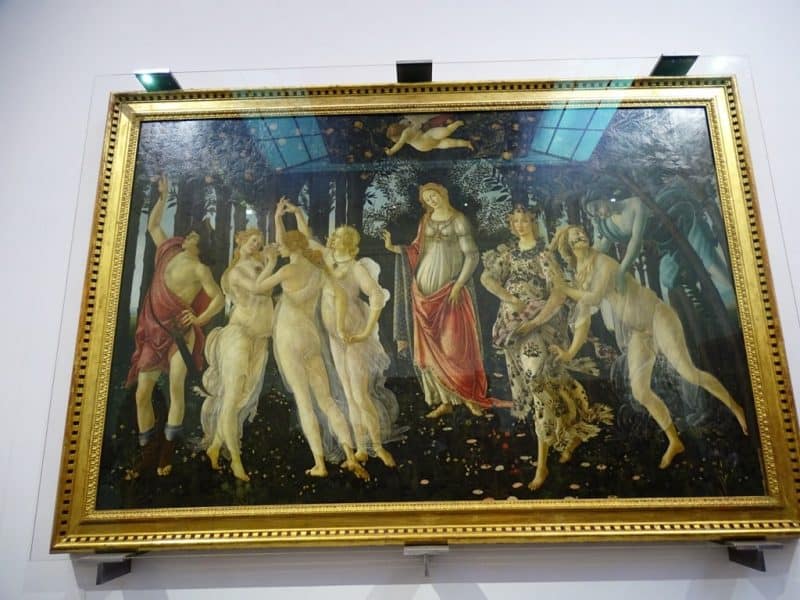
Sandro Botticelli was a prolific painter in the 15th century and was well known for his larger-than-life masterpieces. He painted Primavera when he returned to Florence having been living in Rome whilst he completed frescoes in the Sistine Chapel.
Primavera is a celebration of springtime. Botticelli was commissioned to paint it in 1480 by Lorenzo di Pier Francesco de Medici as a gift for his new bride which they would display on their private estate – Villa di Castello. The painting is considered one of the finest early Renaissance works.
After all his work on Roman Catholic iconography, Botticelli wanted to embrace Roman mythology which he did with this painting and The Birth of Venus. Primavera is also a large painting (202cm X 304 cm) completed in tempera. It depicts a mythological forest. Venus dressed in Italian clothing of the time, stands under an archway of greenery, oranges, and orange blossom. Above her is her son cupid who is firing an arrow at the three graces – Pleasure, Chastity, and Beauty. Mercury, the messenger of the gods, can be seen, and Zephyr, the god of the west wind. Very importantly, the nymph Chloris is seen next to Zephyr and in mythology, she becomes Flora, the goddess of spring.
The detail in the painting is amazing. Botticelli has cleverly incorporated about 500 different species of plants – including nearly 200 different flowers – what a celebration of Spring!
Primavera by Sandro Botticelli is displayed in the Uffizi Gallery in Florence with his other famous painting The Birth of Venus.
Click here to book your timed entrance tickets to the Uffizi.
5. The School of Athens– by Raphael (1483-1520)
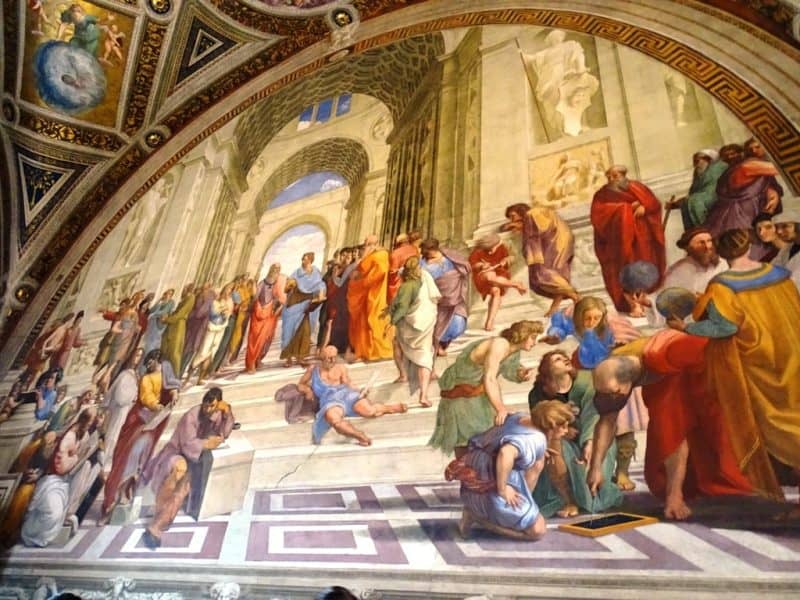
The Italian painter and architect, Raphael Sanzio lived in Urbino, where his father was a painter and man of culture. He died when Raphael was 11 years old, but had already inspired him with his paintings and introduced him to philosophy. By the time he was 16, Raphael had already displayed exceptional talent.
Raphael was invited by Pope Julius II to stay in Rome and to paint wall frescoes in four rooms in the Stanza Della Signatura in the Papal Palace in the heart of the Vatican City. The first room he was to decorate was going to be the Pope’s library and it was the trend in those days to decorate private libraries with portraits of great thinkers. The School of Athens is just one of four frescos in the first stanza.
The School of Athens is a fresco measuring 5 X 7.7 meters and painted in the traditional way on wet plaster. The painting depicts all the famous philosophers of ancient times. In the center of the painting are Plato and Aristotle in discussion – they represent the two different schools of philosophy. Socrates can be seen wearing a brown tunic, while Pythagoras known for his architecture and geometry is dressed in pink and in the foreground. Euclid can be seen showing two students how to use a compass. In the right of the painting stands Ptolemy holding a globe. He is standing opposite the astronomer, Zoroaster and just visible between them is a young man – Raphael himself!
The Raphael Rooms are included in the general admission ticket to the Vatican Museums. The rooms can be found in the Sistine Chapel – they are signposted but can be easily missed.
Click here to book a small group guided tour to the Vatican Museums and the Sistine Chapel.
6. Transfiguration by Raphael
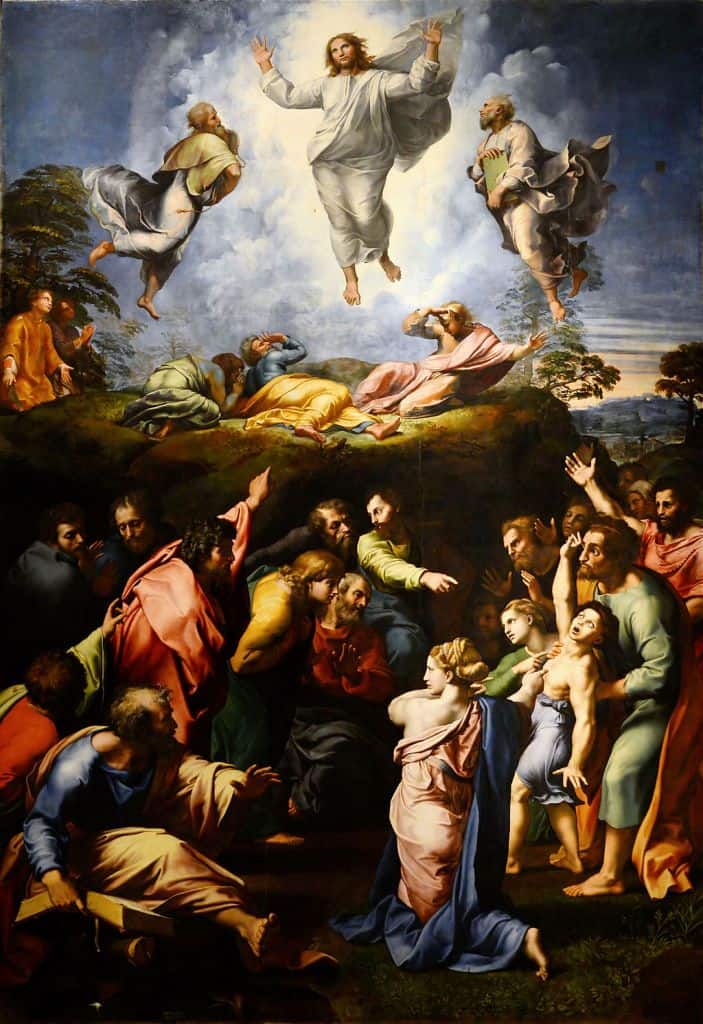
This amazing painting was the last work by Raphael. It was commissioned by Cardinal Giulio de Medici (later Pope Clement VII). The Cardinal was planning to give the painting to the Cathedral in Narbonne, France.
Raphael began painting this sizeable work (410 X 279 cm) in 1516, working with oils on wood. He was never to finish the work as he died prematurely in 1520, aged just 37 years. One of his art students, Giulio Romeno, completed the painting. The Pope loved the painting and did not want to part with it, so he kept it and later donated it to the church of San Pietro in Rome.
Transfiguration is divided into two clear halves. The top half portrays the Transfiguration of Christ on Mount Tabor. Christ is elevated, surrounded by a brilliant light and huge puffy clouds. On each side of him are the prophets Elijah and Moses and below this group are people shielding from the light.
The lower half of the painting is in much more subdued colors and shows the apostles trying to perform a miracle on a boy possessed by evil. The shaft of bright light shining on the boy symbolizes that Christ has performed a miracle on him.
Today, the painting of the Transfiguration can be seen in the Vatican Museum.
Click here to book a small group guided tour to the Vatican Museums and the Sistine Chapel.
7. The Sistine Madonna by Raphael
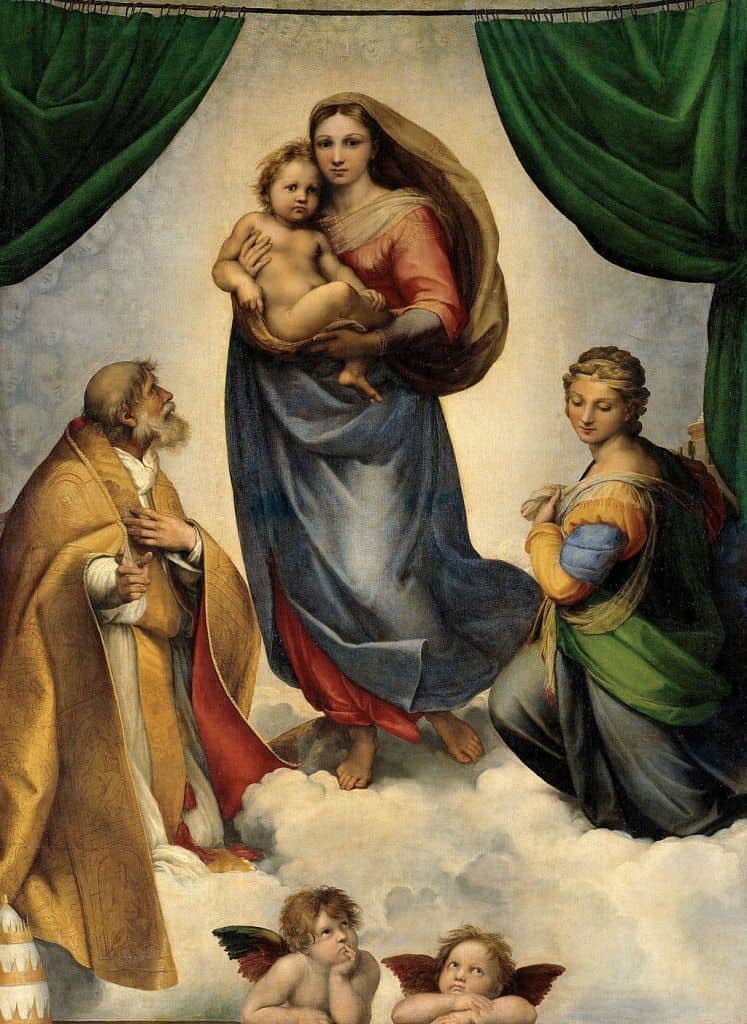
This oil painting, which is also known as Madonna di San Sisto, is one of the most famous Renaissance paintings. It takes its name from the church of San Sisto in Piacenza. Pope Julius II commissioned the painting in 1512 and it was for the altarpiece of the church. The painting was completed in 1514.
The painting is of the Madonna standing on clouds and holding her son in her arms. On one side of her is St Sixtus and on the other, St Barbara. Underneath the clouds are two cherubs. There has been much discussion about the painting because the Madonna and her child both look sad and St Sixtus is pointing out of the painting.
Their expressions can be explained by the fact that the painting was located behind the choir screen and would have faced a crucifix attached to the screen. The Madonna and child are looking at the crucifix, knowing that it will be the future and St Sixtus is pointing out of the painting towards the crucifix for the same reason.
In 1754 King Augustus III of Saxony bought the painting for his collection in Dresden
Today The Sistine Madonna is displayed in Gemäldegalerie Alte Meister in Dresden
Click here to book a 2 -day hop-on hop-off ticket to Dresden that includes skip-the-line access to Alte Meister.
8. Last Judgement by Michelangelo (1475-1564)
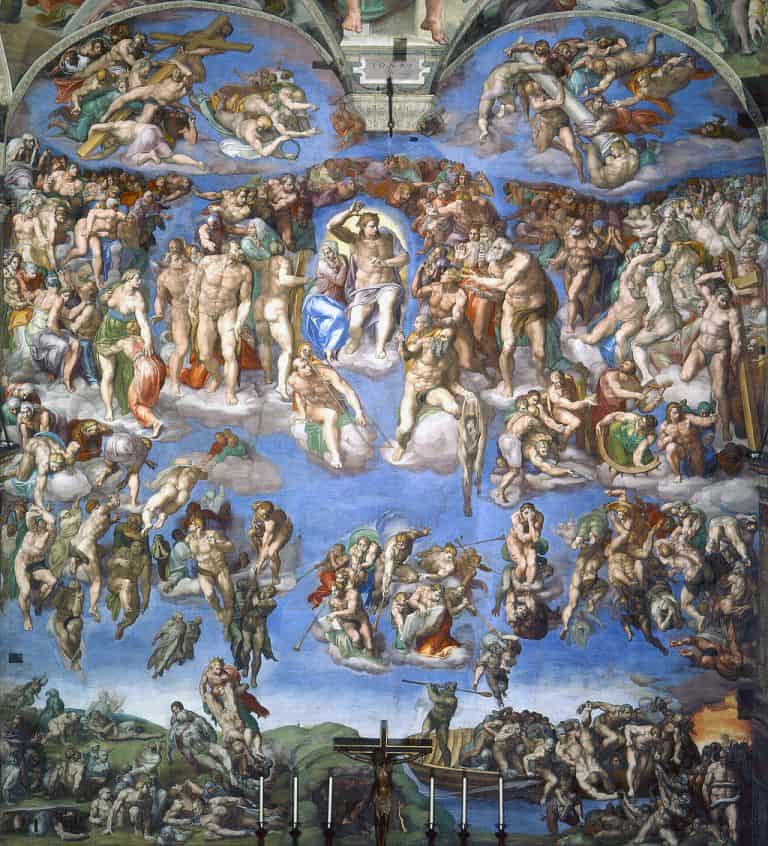
Michelangelo Buonarroti was an acclaimed painter, sculptor, architect, and poet. His work Last Judgement was commissioned by Pope Clement VII, just days before the Pope’s death, and covers the entire east wall behind the altar in the Sistine Chapel. This beautiful fresco is close to the magnificent ceiling also painted by Michelangelo that depicts scenes from the Book of Genesis.
Measuring 13.7 m X 12 meters, Last Judgement was Michelangelo’s second-largest fresco and took him four years to complete (1536 -1541). Interestingly, because 25 years elapsed between the two works, so art lovers can see a distinct change in Michelangelo’s style and artistic vision.
The fresco depicts the Second Coming of Christ and the Last Judgement by God on all humanity. There are more than 300 figures in the painting and even whilst Michelangelo was working on the fresco, it caused huge controversy as the males and angels were portrayed in the nude. Many of the figures were consequently clothed and the figures that remain naked are those of the damned as a mark of humiliation.
Christ is surrounded by his mother and the apostles including San Pietro (St Peter) holding the keys to heaven. The bottom part of the painting is a representation of Hell with a background of a flaming red sky.
The wall had to be specially prepared before Michelangelo could begin painting. The wall was inclined by making it thicker at the top and thinner at the bottom as this would improve the visibility and minimize dust. There were many paintings with the same subject, but Michelangelo’s is viewed as the most radical. Interestingly, other paintings with the same subject were usually placed over the west door so that the congregation was reminded of their possible fate as they left the church.
Last Judgement can be viewed in the Sistine Chapel, Vatican City. It is not possible to visit the Sistine Chapel on its own, only as part of the Vatican Museums.
Unfortunately, the use of cameras in the Sistine Chapel is prohibited.
Click here to book a small group guided tour to the Vatican Museums and the Sistine Chapel.
9. The Creation of Adam by Michelangelo
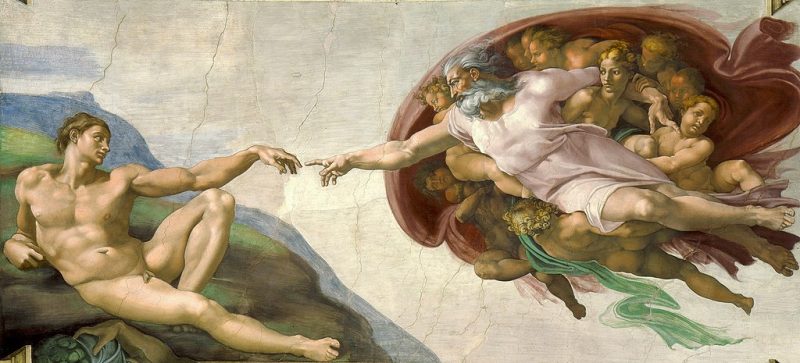
This painting is the most famous part of the beautiful ceiling in the Sistine Chapel that was painted by Michelangelo and depicts scenes from the Book of Genesis. Using paint on wet plaster, Michelangelo painted the ceiling standing on a wooden plank on scaffolding 20 meters above the ground. It is well recorded that the painter was seen regularly rubbing his neck!
In The Creation of Adam, Michelangelo has depicted God on the right with Adam languishing on the left and with God’s outstretched hand almost touching Adam’s having given him life during The Creation. Art lovers are interested that Adam (who is scantily dressed) looks almost like a sculpture and of course, first and foremost, Michelangelo was a sculptor.
The painter’s portrayal of God is also very different from that of his contemporaries who painted God wearing Royal garments and portrayed him as an all-powerful ruler. In complete contrast, in Michelangelo’s painting, God appears much more accessible and closer to ordinary man, as he is painted as a muscular figure with a flowing grey beard and wearing just a light tunic.
10. Bacchus and Ariadne by Titian (1490-1576)
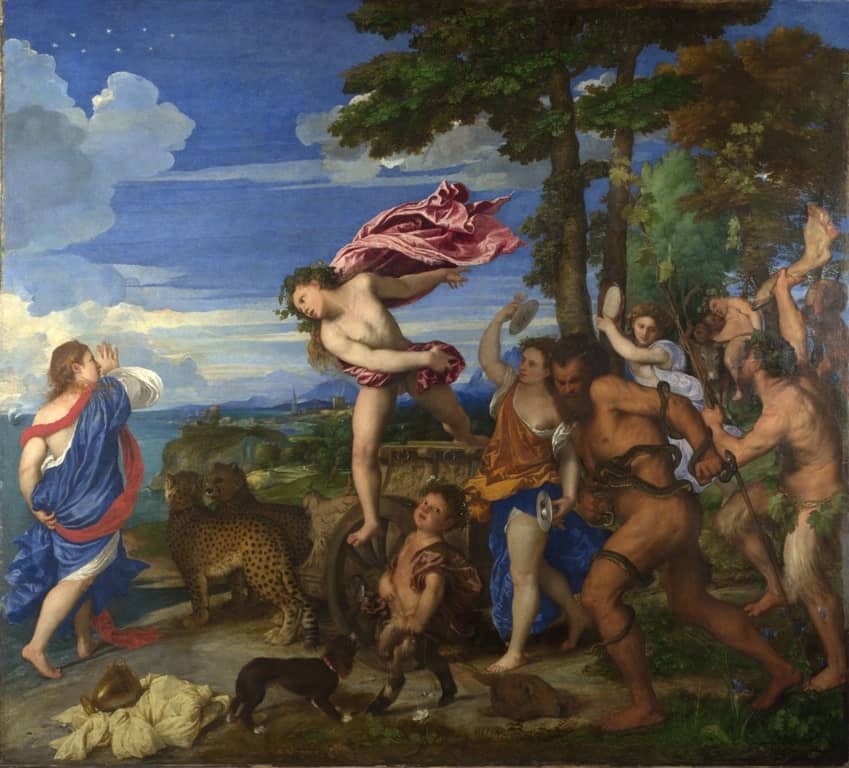
Bacchus and Ariadne was painted in oils by Titan in 1522 and it took him one year to complete. Known as Titian in English, Tiziano Vecelli or Vecellio, was a Venetian painter during the Renaissance. His painting is one of a cycle of paintings on mythological subjects that were commissioned by Alfonso I d’Este who was Duke of Ferrara.
The Duke wanted the paintings for his Camerino d’Alabastro (The Alabaster Room) which was a room in his palazzo in Ferrara. His dream was to collect works by all the great Italian painters and display them together.
The painting portrays a popular mythological story. Princess Ariadne had fallen in love with the Athenian hero, Theseus. They sailed to the island of Crete together to challenge and slay the deadly Minotaur at Knossos – which they succeeded in doing. Later, on the island of Naxos, Theseus abandoned Ariadne while she was sleeping. She was walking along the shore, desperately looking for his ship, when she surprised Bacchus, the god of wine.
He instantly fell in love with her. Later she became his mortal wife and he gave her the sky as a present and eventually, she became a beautiful constellation in it. Bacchus and Ariadne capture the moment when Bacchus and Ariadne meet on the shore and the ship carrying Theseus can just be seen sailing away on the horizon.
Bacchus and Ariadne is one of 19 Titian paintings owned by the National Gallery in London and is displayed in Room 35 in the gallery.
11. Venus of Urbino by Titian
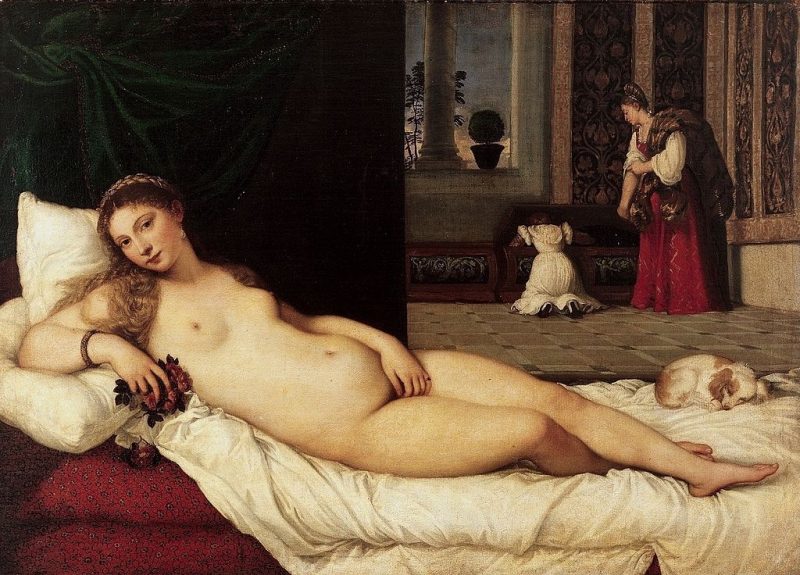
This painting is one of Titian’s best known paintings. The painting was commissioned by Guidobaldo Della Revere to celebrate his marriage to Gila Varanasi in 1534.
The painting is a portrait in oils of Venus as a young bride and about to be dressed for her wedding. Venus of Urbino is said to be one of Titian’s most sensual as it shows the nude Venus reclining in a lavish palazzo. In the background, sits a dog, a common symbol of fidelity and probably also Guidobaldo’s own pet. Behind the dog, two maids are sorting items of clothing that were gifted to her by her husband’s family – as was the tradition.
Venus of Urbino is displayed in the Galleria degli Uffizi in Florence.
Click here to book your timed entrance tickets to the Uffizi.
12. The Beheading of Saint John the Baptist by Caravaggio (1571-1610)
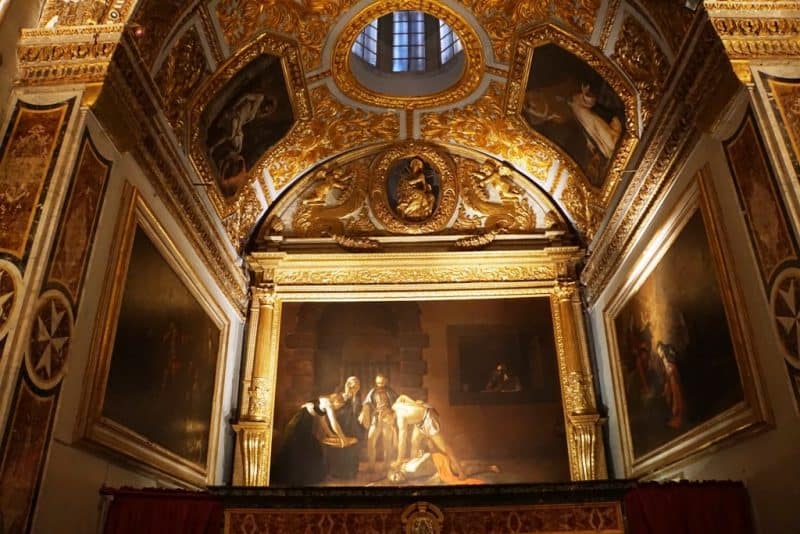
Measuring 370 cm X 520 cm, this painting is by far the largest and most important work of Michelangelo Merisi da Caravaggio – usually known as ‘Caravaggio’. The painting is in oils and was painted in 1608. The subject of the death of John the Baptist was a popular one at that time. Caravaggio painted it for the Knights of Malta and the Cathedral in Malta as John the Baptist was the Patron Saint of both.
In his dramatic painting, Caravaggio depicts John the Baptist on the floor and dressed in his customary red cloak. His head has been partially severed by a sword and the executioner is reaching for a dagger so that he can complete his task.
Salome is holding a platter on which to receive the severed head, whilst the old woman next to her covers her ears so she cannot hear the Saint’s final screams. Blood pours from the head of John the Baptist and provides the ink for the painter’s signature which appears in the pool of blood. This is the only painting Caravaggio ever signed.
Today, The Beheading of St John is displayed in the Knights of the Order of St John’s chapel in St. John’s Co-Cathedral in Valletta, Malta.

